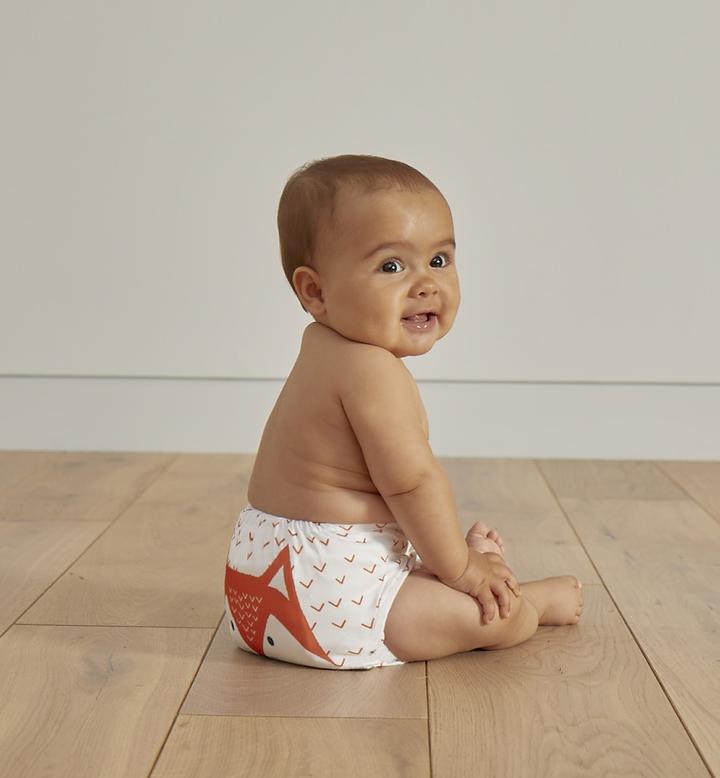Are Kit and Kin Reusable Cloth Nappies Easy to Use?

Are Kit and Kin Reusable Cloth Nappies Easy to Use?
There is a growing population of parents who have done their research and are choosing to use cloth nappies for lots of different reasons – environmental concerns about the amount of disposables they use, financial reasons as cloth nappies are a lot cheaper in the long run, and for general health reasons as cloth nappies don’t contain any chemicals or toxins. It’s a win-win for your pocket and the environment.
Once you start your research you may feel a little overwhelmed with the amount of choice out there and with all of the terminology – it’s like learning a new language! To make it a little easier to get through the jargon, there are some basic things you need to know about our new range of Kit and Kin cloth nappies.
Designed to be simple, Kit and Kin nappies are super absorbent to reduce the chance of any leaks, and once used you can wash them in your machine. They are made from durable fabrics to easily wash and dry, and depending on your little one’s needs you may choose to also use boosters and liners alongside the nappy.
“I was initially a little nervous to try and imagined it would be a little complicated, fussy and messy but it was the complete opposite....we love it! It’s so soft to the touch, beautiful to look at and incredibly absorbent.” @carlyrowena
What type of reusable is the Kit & Kin cloth nappy?
Kit and Kin is an all-in-one nappy, with a double gusset. The inner layer of our Tencel and hemp core pulls out for easy washing and drying. With adjustable hook and loop tabs around the waist as well as poppers, you can adapt the size of the nappy to fit your baby as it grows.
Can I use them from birth?
Absolutely, this nappy is one size fits all and is suitable for newborns (8lbs/4kg+) all the way up to toddlers. This is thanks to the handy poppers and adjustable hook and loop tabs around the waist which means the nappy will always fit your baby’s shape as they grow.
How do I fit the nappy?
The nappy should sit snug around your baby’s torso and thighs. Double check it’s not too tight by placing two fingers inside the waistline. When putting the nappy on, place the back part nice and low so that you can pull the front up as much as possible before fastening the hook and loop tabs. This is important because you want as much of the absorbent lining to play with at the front as possible. For smaller babies, the front should rise high enough to cover the belly button. Please use the poppers to adjust for the best fit. Also make sure the leg cuffs are tucked into your baby’s leg creases.
How do I use boosters?
Boosters are a great way of adding extra absorbency to the nappy if required during the day or at night. Place them inside the nappy on top of the absorbent lining. Kit and Kin boosters are super slim, yet super thirsty, so you can even fold them or add two at a time. If your baby is a boy, use them to add extra absorbency to the front of the nappy, for girls add them closer to the middle. During the night, using boosters is particularly important as they offer the absorbency required for this prolonged period of use. If your baby drinks a lot before bedtime, we even recommend using two boosters.
How should I wash the nappies? Do they need to be washed before use?
Yes, the nappy should be washed before use to increase its absorbency and of course between uses. We recommend machine washing them on a long cycle at 40 degrees with a non-bio powder, as this will protect the longevity of the nappy as well as our planet. However, you can wash them at 60 degrees if you wish, for example if your baby has been ill. Fabric softener or conditioner can reduce the absorbency of the nappy so do not use these. Make sure the drum is no more than three quarters full when loading. Always pull out the inner towel to ensure the best possible wash, and stick the hook and loop tabs together before placing in the machine – this will prevent snagging on the nappy.
How should I dry the nappies?
We recommend air drying your nappies, ideally with the inner fabric exposed to direct sunlight as the sun will naturally bleach the material and speed up drying time. When hanging the nappies to dry, make sure the inner towel is fully pulled out to allow them to dry as quickly as possible. Always keep garments separated to allow air circulation and faster drying. Do not dry directly on a radiator. If you want to tumble dry your nappies, ensure this is done on a cool setting only - however do bear in mind that tumble drying may shorten the lifespan of the nappy.
How many nappies do I need?
This depends on whether you will be using reusables on their own or as part of a mix with disposables, so it very much varies from person to person. You will also need to work out how often you will be washing the nappies as this will affect how many you need - most people tend to do a wash every couple of days. As a guide we’d recommend around 15-20 nappies if you are using them full time, or 8-10 if you’re using them part time. There are three super cute animal designs so you can rotate prints depending on your preference.
How often should I change the nappy?
This will vary depending on your baby and how old they are, but generally we would recommend changing the nappy every 2-4 hours during the day.
Should I use a booster or a liner as well?
The nappy alone is super absorbent, but you may wish to also use boosters and liners to help make nappying even easier. If you're looking for extra absorbency, the Kit and Kin plant-based boosters will add an additional layer and allow you to change less frequently. Simply place the booster on the lining of the nappy, and when it comes to washing you should follow the same instructions as the nappies.
Kit and Kin disposable liners are designed to contain solids and prevent heavy soiling of your nappies. Again, these should be placed on the inner lining of the nappy nearest the skin, but unlike boosters, they are disposable - when the nappy is ready to be changed, lift the liner up carefully and throw it away. Do not flush the liner down the toilet. Disposable liners aren't essential but they make washing nappies less messy.
If you're new to cloth and unsure if you need the accessories, we'd recommend giving them a go, as they should help you find the process that works best for you and your little one.
What should I do when out and about?
When changing your baby’s nappy on the go, simply store your used nappies in any wetbag, which helps make nappy changing quick and simple and once you’re back home you can place it straight in the machine.
I am concerned about leaks. Can you help?
This is something a lot of parents worry about when they consider using reusables. The truth is that they can keep baby just as dry as disposable nappies. Here’s what you need to know:
1) Wash the nappy prior to use
We recommend washing your nappy 1-3 times prior to use. This will increase its absorbency.
2) Ensure it’s fitted correctly
The nappy should sit snug around your baby’s torso and thighs. Double check it’s not too tight by placing two fingers inside the waistline. When putting the nappy on, place the back part nice and low so that you can pull the front up as much as possible before fastening the hook and loop tabs. This is important because you want as much of the absorbent lining to play with at the front as possible. For smaller babies, the front should rise high enough to cover the belly button. Please use the poppers to adjust for the best fit. Also make sure the leg cuffs are tucked into your baby’s leg creases.
3) Change frequently
During the day, change the nappy every 2-4 hours. You will soon get to know your little one and figure out how often they need to be changed.
4) Use boosters to increase and customise your nappy’s absorbency
Place them inside the nappy on top of the absorbent lining. Boosters are super slim, yet super thirsty, so you can even fold them or add two at a time. If your baby is a boy, use them to add extra absorbency to the front of the nappy, for girls add them closer to the middle. During the night, using boosters is particularly important as they offer added absorbency for this prolonged period of use. If your baby drinks a lot before bedtime, we even recommend using two boosters.
We hope this gives you a better idea of the full process of using and re-using cloth nappies and the countless benefits of using them for the long run. Any questions though - just drop us a line. We're experienced cloth nappy users so there isn't much we haven't seen!
